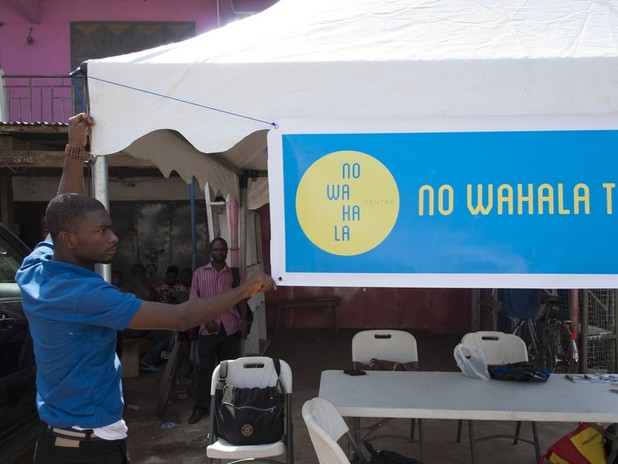September 05, 2013
In part two of our three part prototyping series, John Won shares his experience planning, implementing, and iterating one of four prototypes created by the IDEO.org team and CGAP to increase mobile money usage in Ghana.
As you’ll recall from Cris’s first post in this three part series, our IDEO.org design team, in collaboration with the Consultative Group to Assist the Poor (CGAP) and our client team, is taking on a rapid process of design, prototyping, and iteration in less than two weeks. Our design challenge is to develop new ways to improve the adoption of mobile money programs in Ghana.
On the last day of planning before heading out to the field, the team still hadn't fleshed out one of our four prototypes: a kiosk to deliver high quality customer service to low-income Ghanaians. Each IDEO.org team member, Carla Lopez, Cris Valerio, and myself, all had a few different ideas but hadn't fully aligned on one approach.
So here's how we developed our kiosk, taking into account various ideas to test multiple hypotheses.
1. Sketch and experiment.
If the kiosk concept was to prove valuable to our client and their low-income customers, we hypothesized that it would need to do a few things well: offer a high level of support, make a visible and permanent presence in communities, and strengthen referrals among “touch points” (aka,places where the client is located).
We began with sketches to explore what a prototype might look like - mapping out the prototype’s core features and how to measure its effectiveness. Cris, Carla, and I all had a go at the kiosk, and played around with a number of questions. Does it need to be a kiosk, or can it take on another form? Should the kiosk be targeted to the client's customers, or open to anyone, including competitors's customers? How could we test for a permanent fixture in the community when we had just 10 days in the field?
2. Make a mock-up.
With our planning time quickly running out, we decided to make an ad hoc physical prototype in the office - setting up a kiosk mock-up nearly on top of IDEO.org's core team (Jocelyn Wyatt, Patrice Martin, etc...) in the SF studio! Push together a table, a foam core board, a dry-erase stand, a few chairs, and a little imagination, and we had our kiosk space!
Stepping behind the table, Carla suddenly transformed into a customer service specialist, with another designer playing the role of a savvy consumer. Then we traded places: I stood in the kiosk, and Cris walked by, suspiciously eyeing both the table and me, interrupting our conversation at times to scold her imaginary children (and boy she turned out to be a tough customer!). We tried a few pitches, struggled with curveballs from various types of customers, and grasped for materials and props. Though our exercise lasted just 30 minutes and remained far from the real context, it made our discussions more informed. On the next business day, we flew out to Kumasi, Ghana.
3. Do it again with new questions... and legos.
The night before launching the prototype in the field, we still weren't sure about the person-to-person interactions. Good thing we brought legos! On our hotel coffee table, we assembled miniature people and role played conversations, quickly trying and adapting different versions. It was a moment of productive playfulness that the team needed, and it provided just enough confidence for our first day.
4. Test it with real people.
There's nothing like exposing your ideas to real people and seeing them either do well or fail miserably. For example, we tested if a permanent kiosk location would be valued by residents in a community for convenience of access and flexibility of support. When trying to run the kiosk in one location on a second day, the owner of the lot refused to let us set up again, and we were forced to move to a nearby bus station. Though the hypothesis was technically left unproven, customers did inquire if the kiosk would be returning again the next day, which we took as a a light affirmation of demand.
Testing ideas with real people meant facing practical challenges with our client team, as well, training them in a very different customer service experience. It took time and repeated coaching to break default responses and roles, getting them to try a new script to help us explore the minimum viable contours of a brand new customer experience.
5. Test a different hypothesis each time (and be open to hard questions).
Each day, we iterated on the script and methods that kiosk staff used. We made sure to document types of interactions and track indicators - i.e., new vs. existing customers, or visits to other touch points. Despite all team members being knee-deep in their own prototypes, it was important to take the time to share the kiosk's progress with the whole team. The fresh perspective helped expose what was working and what wasn't, ultimately defining what the kiosk needed to test next.
6. Plan the next experiment.
We came back from the field with one week to go until our project's final meeting. Between synthesizing our prototyping experiences, distilling what we learned, and planning the next experiments to tackle new challenges that had emerged, that week flew by.
One helpful part of our experience was that our client and CGAP teams had worked so closely with us during field work that they could tell the stories from live prototyping as well as we could. Some of them had even gotten the chance to be a part of the prototypes - fielding questions they'd never gotten before, playing videos on a tablet with real people's stories, or piecing together different ways of interacting with customers, lego block by lego block.
To read more about one of our other prototypes, check out Part 3 of our prototyping series by Cris Valerio.




